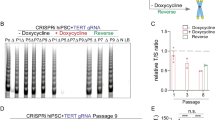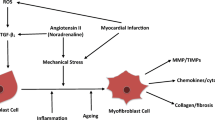Abstract
Previously we showed that cardiac fibroblasts are cellular targets of estrogen and that there are significant differences in proliferative response of male and female cardiac fibroblasts under hypoxia, a condition of myocardial ischemia. Here, we tested the hypothesis that signaling pathways that control cell cycle progression and apoptosis in cardiac fibroblasts may be activated in a gender-specific manner. Cardiac fibroblasts from adult, age-matched male and female rat heart were exposed to hypoxia (2% O2) and normoxia. Western analysis of cell lysate was used to compare the level of basal and hypoxia-induced expression of signal transduction proteins, known to control cell cycle progression and cell death. Hypoxia led to significant activation of MAP (mitogen-activated protein) kinase and Jun kinase pathways, as shown by phosphorylated extracellular signal-regulated kinase (ERK1/2) and Jun kinase isotypes in male cells but this effect was modest in female cells. Male cells expressed higher levels of basal expression for transcription factors c-jun and NF-kB as well as the inhibitor of NF-kB (lk-B). Although hypoxia did not induce changes in the level of c-Jun in either cell type, it moderately increased the level of NF-kB in male cells but led to its decrease in female cells. Basal and hypoxia-induced expression of cyclin D1, c-fos, and PCNA seemed to be comparable in both male and female cells. However, hypoxia-induced activation of cyclin B1, which occurred in both cells, was stronger in female cells. Basal expression of apoptosis-associated transcription factor, p53, was comparable in both cells. However, under hypoxia, there was an increase in the p53 level only in female cells. Although female cells showed higher basal expression for survival-associated protein, Bcl-2, the level of this protein remained unchanged under hypoxia in both cells. Together, these data demonstrate differences in basal and hypoxia-induced expression of proteins with an established role in cell cycle progression and apoptosis in male and female cardiac fibroblasts. These differences may further point to gender-related differences in signal transduction pathways that control the proliferative response of those cells under hypoxia.
Similar content being viewed by others
References
Lee, H.-W. and Eghbali-Webb, M. (1998). J. Mol. Cell. Cardiol. 30, 1359–1368.
Dubey, R. K., Gillespie, D. G., Jakson, E. K., and Keller, P. J. (1998). Hypertension 31, 522–528.
Grohe, C., Kahlert, S., Lobbert, K., Van Eickels, M., Stimpel, M., Vetter, H., et al. (1997). Pharmacology 121, 1350–1354.
Grohe, C., Kahlert, S., Lobbert, K., and Vetter, H. (1998). J. Endocrinol. 156, R1-R7.
Agocha, A. and Eghbali-Webb, M. (1997). J. Mol. Cell. Cardiol. 29, 2233–2244.
Griffin, M., Lee, H.-W., Zhang, J., and Eghbali-Webb, M. (2000). Mol. Cell. Biochem. 215, 21–30.
Sadoshima, J., Jahn, L., Takahashi, T., Kulik, T. J., and Izumo, S. (1992). J. Biol. Chem. 267, 10,551–10,560.
Schorb, W., Booz, G. W., Dostal, D. E., Conrad, K. M., Chang, K. C., and Baker, K. M. (1993). Circ. Res. 72, 1245–1254.
Sigel, A. V., Centrella, M., and Eghbali-Webb, M. (1996). J. Mol. Cell. Cardiol. 28, 1921–1929.
Simm, A., Nestler, M., and Hoppe, V. (1997). J. Mol. Cell. Cardiol. 29, 357–368.
Eghbali, M., Tomek, R., Sukhatme, V., Woods, C., and Bhambi, B. (1991). Circ. Res. 69, 483–490.
Libby, P. (1984). J. Mol. Cell. Cardiol. 16, 803–811.
Huber, S. A., Kupperman, J., and Newell, M. K. (1999). Lupus 8, 384–3887.
Sweatt, J. D. (2001). J. Neurochem. 76, 1–10.
Lin, A. W., Barradas, M., Stone, J. C., van Aelst, L., Serrano, M., and Lowe, S. W. (1998). Genes 12, 3008–3019.
Lim, I. K., Hong, K. W., Kwak, I. H., Yoon, G., and Park, S. C. (2001). Ann. NY Acad. 928, 176–181.
Nuedling, S., Kahlert, S., Loebbert, K., Meyer, R., Vetter, H., and Grohe, C. (1999). FEBS Lett. 454, 271–276.
Kato, S., Endoh, H., Masuhiro, Y., Kitamoto, T., Uchiyama, S., Sasaki, H., et al. (1995). Science 270, 1491–1494.
Semenza, G. L. (2000). Genes Dev. 14, 1983–1991.
Carmeliet, P., Dor, Y., Herbert, J. M., Fulumura, D., Brusselmans, K., Dewerchin, M., et al. (1998). Nature 394, 485–490.
Takizawa, C. G. and Morgan, D. O. (2000). Curr. Opin. Cell Biol. 12, 658–665.
Pluquet, O. and Hainaut, P. (2001). Cancer Lett. 174, 1–15.
Toda, I., Sullivan, B. D., Wickham, L. A., and Sullivan, D. A. (1999). J. Steroid Biochem. Mol. Biol. 71, 49–61.
Evans, M. J., Eckert, A., Lai, K., Adelman, S. J., and Harnish, D. C. (2001). Circ. Res. 89, 823–830.
Pelzer, T., Neumann, M., de Jager, T., Jazbutyte, V., and Neyses, L. (2001). Biochem. Biophys. Res. Commun. 286, 1153–1157.
Author information
Authors and Affiliations
Corresponding author
Rights and permissions
About this article
Cite this article
Zhao, X., Eghbali-Webb, M. Gender-related differences in basal and hypoxia-induced activation of signal transduction pathways controlling cell cycle progression and apoptosis, in cardiac fibroblasts. Endocr 18, 137–145 (2002). https://doi.org/10.1385/ENDO:18:2:137
Received:
Revised:
Accepted:
Issue Date:
DOI: https://doi.org/10.1385/ENDO:18:2:137




